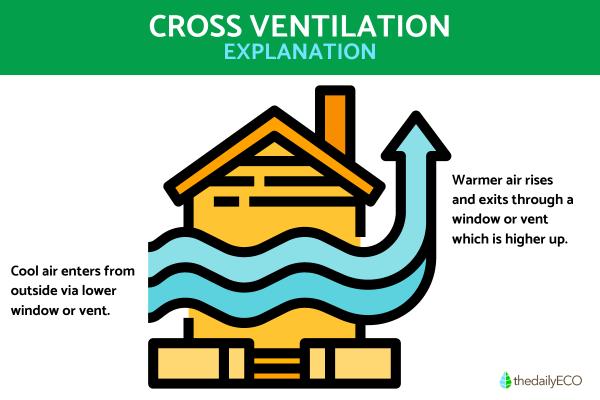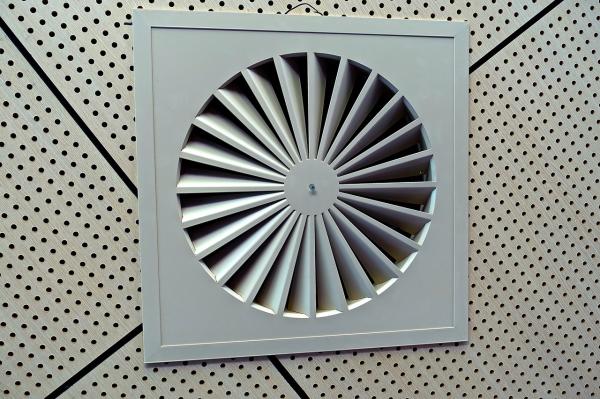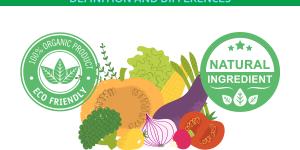What Is Cross Ventilation? - Definition


Cross ventilation is a term widely used in architecture and structural engineering. It is especially important when devising air conditioning systems for various buildings, including residential homes. There are different methods of ventilating a home which are largely dependent on the methods of wind entrance and extraction. Cross ventilation and other types of ventilation are defined by the direction of air flow throughout a property. In houses, these are mostly controlled by openings such as doors and windows.
At thedailyECO, we discover more about air flow in the home by asking what is cross ventilation? We provide a definition of cross ventilation, as well as look at its advantages and disadvantages in the home.
What is cross ventilation?
Cross ventilation is a method of ventilation that involves the movement of air through a space from one side to the other. The main objective of cross ventilation is to renew and improve the quality of indoor air. It is also important in regulating temperature and humidity in the home. This will help ensure the wellbeing of people in the home, reduce energy costs and minimize waste.
The cross ventilation diagram in the main picture of this article shows the basic flow of air through the home this type of ventilation is used.

How does cross ventilation work?
In general, cross ventilation is achieved by taking advantage of the differences in air pressure and temperature between the interior and exterior of a building. To do so, it is essential there is a strategic placement of openings, such as windows or doors. For cross ventilation to occur, the openings need to be on opposite sides of the building. This will allow fresh, cool air to enter through one opening and stale, warm air to exit through the other.
When there is a significant difference in temperature and pressure between the air outside and inside the building, a natural airflow is generated through the openings. This airflow helps remove excess moisture, pollutants, odors and other harmful agents from indoor air. In addition, cross ventilation helps maintain a more comfortable and consistent temperature inside the building.
In warmer climates, cross ventilation can be especially helpful in reducing the need for air conditioning systems. This is because it allows cool air to circulate naturally and dissipates internal heat buildup. In colder climates, more attention must be paid and a balance must be sought in order to avoid excessive heat loss through ventilation.

Cross ventilation advantages and disadvantages
Cross ventilation can be an option to choose in a home or building that needs its air quality improved. Whether that be to control ambient temperature, reduce humidity or remove stale air, it is a good option for many people. However, it is not a solution applicable to all spaces. In some cases, the disadvantages may outweigh the advantages. We look at the pros and cons of cross ventilation in the home to see if it is suitable for your space:
Advantages of cross ventilation
- Improves indoor air quality: allows the renewal of indoor air thanks to the elimination of pollutants, odors and accumulated humidity. Doing so contributes to maintaining a healthier and more comfortable environment for the inhabitants of the home.
- Reduced energy consumption: in hot climates, cross ventilation can help reduce the need for air conditioning systems. This leads to less energy consumption and helps to reduce our reliance on fossil fuels. In addition, it is important to mention that it also saves on electricity costs, especially since the price of this utility is increasing. Find out other ways to keep your house cool without air conditioning in our related article.
- Temperature control: the circulation of fresh air contributes to maintaining a more comfortable temperature inside the building, especially in areas without artificial air conditioning.
- Fosters connection to the outdoors: by allowing outdoor air to flow through the building, cross ventilation provides the people living in the home with a closer connection to their outdoor environment.
- Decrease in the concentration of CO2: air renewal helps reduce the concentration of carbon dioxide (CO2) inside the house, which can improve air quality and the well-being of people. This is beneficial to the health of the same.
Disadvantages of cross ventilation
- Depends on weather conditions: the effectiveness of cross ventilation can be affected by weather conditions. In climates or particular environments which are sheltered from wind or experience a significant difference between outdoor and indoor temperatures, cross ventilation may be less effective.
- Risk of entry of pollutants: if the outside air is polluted, as in large cities or urban areas with high levels of pollution, cross ventilation can introduce said pollutants into the interior of the building. This can harm the health and wellbeing of the occupants of the home.
- Potential Security Concerns: opening windows or doors in some environments can pose security concerns, such as potential home burglaries.
- Humidity control: in climates with high humidity, cross ventilation can introduce humidity inside, which could be unfavorable in certain environments or times of the year.
- Requires proper design: to fully reap the benefits of cross ventilation, the building must be properly designed with strategically placed openings to allow for optimal air movement.
In conclusion, cross ventilation can be an effective strategy to improve indoor air quality, as well as reduce energy consumption in homes or large buildings, but it is necessary to take into account the climatic conditions and the location of the house or building to increase your benefits and minimize those possible inconveniences that may occur.
Now that you know what cross ventilation is and how it is achieved, you can discover how plants can help keep cool with our article on plants that absorb heat.

Other types of ventilation in the home
As we have seen by sharing the advantages and disadvantages of cross ventilation, it is not the solution to everyone's home ventilation needs. For this reason, we need to look at the different types of ventilation which we can use in the home. These are grouped under two main categories:
- Natural ventilation: harnesses the local weather by allowing wind and natural cool air to enter the home via windows or vents. Cross ventilation is an example of natural ventilation.
- Mechanical ventilation: uses electronic devices to allow ventilation in the home which can occur regardless of the weather conditions. The different types of air conditioning units are the most common examples of mechanical ventilation.
Within these two types of ventilation in the home, we can see varying approaches. They include the following:
Natural Ventilation
- Stack ventilation: stack ventilation relies on the principle of warm air rising and cool air sinking. In a home, this can be achieved by installing vents or openings near the top and bottom of a room or building. As warm air rises and escapes through the upper vents, cooler air is drawn in through the lower vents, creating a natural airflow. This is a type of cross ventilation.
- Wind-driven ventilation: wind-driven ventilation utilizes outdoor wind pressure to create airflow within the home. This can be achieved by strategically placing openings or vents to catch prevailing winds and channel them into the interior spaces, promoting air exchange.
- Chimney effect: this type of ventilation occurs in homes with a chimney. As air is warmed by a fire in the fireplace, it rises through the chimney, creating a negative pressure that draws in fresh air from the surrounding areas, improving overall ventilation.
Mechanical Ventilation
- Exhaust ventilation: exhaust ventilation uses mechanical fans to remove stale or polluted air from specific areas in the home, such as kitchens, bathrooms and utility rooms. The expelled air is typically vented to the outdoors, creating a negative pressure that draws in fresh air through gaps and openings in the building envelope. It is particularly useful in rooms with a lot of humidity such as kitchens and bathrooms as it reduces moisture damage.
- Supply ventilation: supply ventilation introduces fresh outdoor air into the home using mechanical fans. The incoming air is filtered and distributed to various rooms, ensuring a continuous supply of fresh air and reducing the potential for indoor air pollution.
- Balanced ventilation: balanced ventilation combines both exhaust and supply ventilation systems to maintain a balanced airflow within the home. This approach ensures that an equal amount of air is exhausted and supplied, promoting effective ventilation and preventing pressure imbalances.
- Heat recovery ventilation (HRV) and energy recovery ventilation (ERV): HRV and ERV systems are advanced mechanical ventilation systems that recover heat or energy from the outgoing air and transfer it to the incoming fresh air. These systems help improve energy efficiency while providing fresh air and maintaining indoor comfort.
The choice between natural and mechanical ventilation depends on various factors, such as the climate, building design, energy efficiency goals and specific ventilation needs. A well-designed ventilation strategy can contribute to better indoor air quality, moisture control and overall comfort in the home. It is essential to consider local building codes and best practices when implementing ventilation systems in residential settings.
If you want to read similar articles to What Is Cross Ventilation? - Definition, we recommend you visit our Ecology (other) category.








